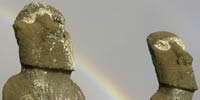Big Stone Heads


 7:45
Jack Chance
7:45
Jack Chance
A trip to Easter Island to gather recordings of local musicians and theories on who made and moved the "moai," the isle's famous stone heads.
Broadcast: Mar 7 2007 on PRX Nature Stories Podcast; Nov 14 2004 on NPR Day to Day
 One of the many local names for Easter Island is Te Pito Te Henua, which means the end of the earth. It's the most remote inhabited island on the planet, more than 2000 miles off the west coast of South America. Anthropologists think the island was settled by Polynesian sailors around 300 AD, probably following the migration patterns of sea birds. The Rapanui people had been been isolated from the outside world for over a thousand years when a Dutch ship spotted them on Easter Sunday 1722. These days the island is claimed by Chile, and the islanders speak Spanish as well as their native language. Jack Chance spent six weeks on the island, recording local musicians and trying to unlock the mysteries of the great stone faces.
One of the many local names for Easter Island is Te Pito Te Henua, which means the end of the earth. It's the most remote inhabited island on the planet, more than 2000 miles off the west coast of South America. Anthropologists think the island was settled by Polynesian sailors around 300 AD, probably following the migration patterns of sea birds. The Rapanui people had been been isolated from the outside world for over a thousand years when a Dutch ship spotted them on Easter Sunday 1722. These days the island is claimed by Chile, and the islanders speak Spanish as well as their native language. Jack Chance spent six weeks on the island, recording local musicians and trying to unlock the mysteries of the great stone faces.
The thing about Easter Island is that it's in the middle of nowhere, a thousand miles from the nearest anything, an otherwise unimportant island in the south pacific. Otherwise unimportant if it weren't for the Moai, you know, the big stone heads, you've probably seen em on tv.
A local sculptor named Kai invites me to stay at his house. His yard is full of works in progress, carved from scraps of wood or red volcanic rock. Over there's a gravestone for his father, who died last week. Since Kai seems to be carrying on the sculpting craft of his ancestors, I figured maybe he could clue me in on how the mysterious statues, which weigh up to 80 tons, were built.
He tells me ancient chiefs made the statues walk using supernatural mental powers, which they got from martians. He's just messing with me, but the local legend says that the moai really did walk from the volcanic quarry to their positions along the rocky coast.
Some archaeologists think the moai were transported using palm trees rolled underneath the immense stone sculptures. But the few trees here today were introduced by foreigners. If these archaeologists are right, the Rapanui deforested their island completely in order to build their statues.
I walk around the island for a few days, checking out the petroglyphs hidden in the grass and the half buried moai, left unfinished at the quarry or lying derelict along the shoreline. There are hundreds of them, but the ones you see standing in photographs have all been resurrected by foreign archaeologists.
But i'm no archaeologist, I came here to find out what kind of music the locals play. Luckily I meet Dan Bendrups, an Australian ethnomusicologist.
After months of research on the island, he's brought one of the most respected Rapanui musicians out of retirement. Together with another student, Papa Kiko sings us this song, which he wrote when the first moai were resurrected in 1960.
The thing about Easter island is that there are no trees. The palms went extinct centuries ago, so they could move the big stone heads. Went extinct to build the big stone heads so there wasn't any wood left. No wood to build fishing boats or to escape the island. Some of the greatest navigators who ever lived, found little old Easter Island out in the empty blue waters, and there's no wood left. No wood left to go fishing. No wood left for fires. No wood left to escape. No wood left cause they built those big stone heads. You know some guy went to work one day and his boss says, "Hey, cut down that palm over there." And the man looks at the last tree on the island and he goes and does his job. Cuts down the last tree on the island and...no more wood.
And he gets his paycheck and the white folks come on an Easter Sunday and they baptize the nonbelievers with hydrochloric acid and the islanders get small pox on the slave ships. The families back home sit on the reservations and turn to war and cannibalism, and they topple every last one of the big stone heads. And then the white people find out about the toppled heads and the dying culture and they come back with anthropologists and photographers to marvel at the big stone heads all toppled on the ground. And the anthropologists and photographers bring some money and they resurrect the big stone heads and the tourists come and they let the locals off the reservations and the locals grow dreadlocks and raise horses in the treeless hills cause man went to work one day and left em all stranded.
The thing about Easter Island is that it's in the middle of nowhere, a thousand miles from the nearest anything, an otherwise unimportant island in the south pacific, on this island called earth.
